Help with mainting Soap Stone
We moved into our home 2 years ago, it had fairly recently installed soapstone counter tops. I have no idea where the previous owner purchased them.
We've tried putting mineral oil on them, and it didn't
really seem to absorb, it just sat on the surface for days, more in some places than others. Anyway, it didn't really seem to help.
We have lots of marks from water, glasses, you name it. It seems impossible to make it look decent.
What have you tried on your soapstone to make it look better?
Comments (38)
segbrown
15 years agoI was at Dorado Soapstone in Denver last week, and they were all excited about a new wax that they've formulated and have started rubbing on their stones. Apparently it lasts for months ... they're not sure exactly how long, because it's so new, but suggested maybe reapplying every 4 months or so, maybe less.
I have two stone samples from them; they put the wax on it, and after a week they look the same.
I would contact them and see if they are selling it yet.
oruboris
15 years agoOil isn't supposed to 'absorb', really.
It settles in the micro-grooves of the surface and oxidizes, turns the stone the same color as it would eventually achieve without the oil.
So you wipe on, wipe off. After a few days, when the sheen is gone, you do it again. And again.
And then you do it every few weeks, then every few months.
Once it's 'done', it shouldn't show water marks, etc.
As to a new super wax that needs less frequent application, weeeeelllllllllll, ok: cool. But once the oil is established [for lack of a better word] on the countertop, it should last for months, too.
Related Professionals
Arcadia Kitchen & Bathroom Designers · Montrose Kitchen & Bathroom Designers · Ocala Kitchen & Bathroom Designers · Owasso Kitchen & Bathroom Designers · Springfield Kitchen & Bathroom Designers · Ogden Kitchen & Bathroom Remodelers · Wilmington Island Kitchen & Bathroom Remodelers · Avocado Heights Cabinets & Cabinetry · Hammond Cabinets & Cabinetry · Hanover Park Cabinets & Cabinetry · Prospect Heights Cabinets & Cabinetry · Central Cabinets & Cabinetry · Tabernacle Cabinets & Cabinetry · Davidson Tile and Stone Contractors · Chaparral Tile and Stone Contractorsguy_in_newhouse
15 years agoI bow to Joshua's knowledge of the stone & what is shown is accurate in my experience with new soapstone. The problem is that a kitchen counter is constantly being impacted by glass rings & wipe-downs with dishrags and the "clean off the mark & reoil" cycle never stopped...in the first few weeks at least. Maybe with time you get out of the cycle, but I'm wasn't there yet...and I wanted to move on to other things.
There has been a mineral oil-beewax combo mentioned here on GW. I did some searching and ended up with a mineral oil-beeswax-carnauba wax mixture that seems to work very well so far. Carnauba is a hard-nontacky wax(there aren't many of them) & I think would be a step up from beeswax. It takes about a week to transition from the wet-luster look to dry stone, but once there the soapstone looks dark & dry, but wipes up without leaving the "I just wiped off the mineral oil" look. The surface is smooth & non-tacky also. Do a search on amazon for mineral oil beeswax carnauba (it sold by "chef's catalog" I think) & you'll find it.
cheri127
15 years agoBayareafrancy had the same problem you're having and she solved it by oiling with grapeseed oil (which she found reasonable priced at Trader Joe's). Another option would be not to oil. Bucks County Soapstone sells a liquid sealer of some kind that's very easy to apply and keeps the stone gray (ie. no oil marks from cooking). I tried it on a sample of Black Venata and the side of the stone that had been coated did not turn dark with oiling. The coating didn't change the look or the feel of the stone at all. Unfortunately, I have no idea what this stuff was but I'm sure if you email them, you can find out. Good luck.
Here is a link that might be useful: Bayareafrancy's soaptstone patina thread
cat_mom
15 years agoNot to hijack,but guy_in_newhouse, you'd mentioned that product on my thread re: product to use with wood (cutting boards, decorative bowls and baskets). Do you know if this prodcut leaves a lusterous (yet non-tacky of course) finish on wood?
I don't want the wood to look oily, or have a wet-luster look per se, but do want it to maintain a nice soft luster for a decent period of time (lengthier than straight mineral oil leaves it). Within a very short period of time after wiping down with the oil, the bowls edges look pretty dry.
Thanks!
kswartwout
Original Author15 years agoThanks for the suggestions. I guess I've never really given it a go with the frequent oiling/waxing. I'll pick up either some grapeseed oil or one of the combo wax/oils and see what happens. I'll try and get my act together to post before and after pics, for anyone else who might be in the same boat. Any more recommmendations on a good place to buy an excellent wax/oil product at a good price would be appreciated.
Babka NorCal 9b
15 years agoI've used the grapestead oil a couple times and it did do better then regular mineral oil. Then I noticed one splotch in my prep area that always remained darker. I've had my counters for over 3 years and this man-made darker swoosh mark is a relatively recent appearance. I asked myself what I couldn've spilled on the counter that is remaining dark even after repeated wipings with a soapy dishcloth. EVOO!
So I lightly oiled the whole area with extra virgin olive oil (it only took a couple tablespoons to do a 3'x6' area)and wiped it off with a micro fiber cloth after about 30 minutes.
So far, even the area around the soap dispenser doesn't water mark.
Who'd a thunk it? So why not spill a few drops of EVOO on your soapstone, wipe it off with a paper towel and see if it works for you too. Nothing to lose and you can even lick your fingers afterward!
-Babka
guy_in_newhouse
15 years agoI wouldn't use any vegetable or animal-base oil as they typically all go rancid at some point. If the oil is unsaturated (making it a liquid at lower temps) it'll polymerize eventually (look for the sticky-gooy material around the cap of a cooking oil bottle...this will happen on your countertop eventually). "Dry-able" oils (oils that cure-polymerize in air) are the basis of a whole line of wood finishes (tung oil , linseed oil, 'danish' oil...). If the oils don't cure completely (most likely) then you'll have a situation where short-carbon chain oils (12-16 carbon chain) grows into longer chains that are often referred to as adhesives..and they will have a tacky surface. I think using cooking oils is asking for a fair bit of elbow grease somewhere in the future in getting it off.
cat_mom....straight wax like carnauba or beeswax is a very old finish for wood. The chefs catalog material shouldn't give you a wet or tacky finish. Pure carnauba will not be tacky once you buff it out. Once it's buffed out there might be a slight sheen...depending on how rough the surface is. If your bowls edges are end-grain of the wood it'll be very tough getting any wax type finish to not look 'dry' unless the endgrain is sanded to a very fine nonporus finish first. There are food safe finishes (google "salad bowl finish") that might seal the edges better, but it's hard to say as I'm not completely sure what you're dealing with or trying to do. Shellac will seal it & it's dry, non-tacky & food safe. You can then wax over the top of that.
Babka NorCal 9b
15 years agoGuy in new house- You appear to be very knowledgeable about coatings, however I don't think you are familiar with soapstone. The oil doesn't soak in, and you wipe it off. There is no build-up. There isn't enough there to get rancid or tacky. This is more like an oil stain on your clothes after it goes through the washer and dryer. The area is darker, but doesn't feel oily.
I hope someon else with soapstone will try EVOO on a small area and see if their results are the same as mine. I have Marina soapstone, one of the harder varieties, and I am curious about the other types.
-Babkaberf
15 years agoHmmm babka, I'm not sure--I haven't had my soapstone near long enough to be an authority but my experience and instincts tell me that guyinnewhouse is on to something. Glass is not porous, nor are my pots--but even a thin veil of evoo left on those surfaces does, after time become very very tacky. It may not feel oily, but it is just sitting there in those "micro grooves" and not soaking in--so I suspect it could go rancid...but I just might take you up on it and apply it to a small spot and see what happens over time. I'll let you know!
I've settled in to a routine with mineral oil, but only about once every week or two (mainly for guests)..we are kind of enjoying the rustic look most days, some scrubbed to gray after we clean up, other areas with oil or turing blacker--I haven't focused much on trying to keep an even sheen. When I do oil, I wipe thoroughly with the microfiber just as you suggested which I find gives it a perfect matte finish.
cat_mom
15 years agoguy_in_newhouse--the bowl/baskets are carved tree roots, an old chopping bowl (my grandmother's), and the cutting boards are linked below (striped, multi-toned wood; FYI: we bought ours at an area crafts show in the early to mid '90's--I think we paid a lot less back then! They've held up beautifully, BTW--replaced the rubber feet on the one with feet last year, that's it). The cutting boards and chopping bowl are washed and oiled after each use (using the damp paper towel that had been used to dry them). No real need to remain lustrous or picture-perfect, as they are stored in a drawer. They're just oiled to keep the wood from drying out (and the colors look nice and rich for me when I use 'em!).
The decorative bowl/baskets seem to be less porous, so the oil sits on the surface more (rather than absorbing as it does on the cutting boards). If I wipe every drop of oily residue from the surface, the items tend to lose their sheen/luster (which brings out the graining and make the different wood tones really "pop"). If I leave oil sitting on them though, they look oily in spots.
I guess I'm looking for something that I rub/buff on any or all of the above items so they will have luster, that enhances the wood's grain/tones, but does not leave them oily in look or feel. I also don't want a big project on my hands (which was why I'd asked on my thread about product recommendations--not looking to make my own, or to spend a ton of time buffing in whichever product I end up using).
Here is a link that might be useful: David Levy Cutting Boards
Babka NorCal 9b
15 years agoI meant to say "Mariana" soapstone, not marina. Duh.
Berf- That was my concern too when Francy first suggested the grape seed oil, but after using that for several months without it getting tacky (or smelly), and noticing that one specific darker area that never seemed to change, I had to try the EVOO. This area is my sink island that gets wiped with a soapy cloth at least twice a day. I think the trick is to wipe it off really well.
As you know, just a wipe with strong detergent removes any traces of oil on soapstone, (so does blue painter's tape)so you have nothing to lose by trying it.
Please post again if you try it.
-Babka
guy_in_newhouse
15 years agobabka,
yes I've worked in the polymer/coatings industry for 20+ years. Berf describes it better than I, concentration or coating thickness doesn't matter. All these oils will go rancid eventually. The stickyness may be avoided by the material wearing off, but, these oils will decay/polymerize & get tacky eventually. As for soapstone...I'm not into the non-organic side of things, but soapstone is made of "talc"...talc is a silcate, silicates exist physically in the form of flat platelets (on a an angstrom-scale) that lie flat on top of each other so closely that the bonding between them prevents other materials from seeping in (there are minimal or no interstices). This tight platlet packing exhibits itself to you & me as a "non-porous" material.
eandhl
15 years agoI do not use veg oil but this got me thinking. On a cutting board the oil would be absorbed and could certainly go rancid. On soapstone it just sits on top, get washed off, wears off etc until the stone is naturally darker. I would think this could/would prevent the chance of it getting rancid. ???
growlery
15 years agoBut the olive/cooking not wearing off evenly. There's always some somewhere.
I know clothes and towels, even ones that go through several washes after cooking oil, are permanently rancid. Molecules stick around even when the visible oil is washed away. And of course, fine oil spray from cooking is always raining down on surfaces too. You'd have to do some INSANE cleaning to get it all off.
I'd stick to mineral oil/beeswax. That's my plan anyway. But to each his own.
guy_in_newhouse
15 years agoeandhl,
Veg & animal oils on cutting boards is not a good idea for the same reason--they "age badly". Food safe waxes are fine (carnauba, beewax..or mineral oil). RE: soapstone...yes..wearing veg or animal fats off the surface may prevent one from ever seeing the 'sticky stage'...except for corners or back edges where there isn't wear. In my mind...it's possible that veg/animal oils may not cause an issue due to the environment it's used in...but with other very good alternate options available, why not use one of them instead?growlery,
The thing with stains on some fabrics is that some synthetics are made of fibers that are hollow. If whatever you get on the fabric is there long enough to migrate inside the fiber shell, then getting it out of there is nearly impossible and the stain goes permanent. The molecules and the oil are the same thing...an unsaturated hydrocarbon chain around 12-14 carbons. Once they oxidize (through the unsaturated bonds) two chain molecules become one larger molecule (i.e. a branched 28 carbon chain rather than two 14 carbon chains)...as the chains continue to oxidize ("go rancid") they get bigger and bigger. Getting them off the fabric then becomes a effort much like pulling an octopus off a glass window. You may get one or two otco-arms free, but 6 others are hanging on tight. Drop one you have free to grab another and it reattaches and you lose.From a chemical standpoint, lard or crisco would be a better dressing than an unsaturated cooking oil. Like you, I'm sticking with a wax-mineral oil combo, so far I like it better than mineral oil alone.
debsan
15 years agoWhether or not Babka & I will be paying the price by living with rancid oils on our counters, she's right. I use Dawn detergent and it totally strips the oil off the stone around the sink. After reading her post, I decided to try the EVOO. It seems to be hanging on. The edges of the sink look like everything else, without the ghosting that usually appears as the oil (I use beeswax/mineral oil mix) starts to be dissolved.
Other than the unpleasant smell, what's the downside of rancid oil on a surface that isn't used for food??? Really, I'm curious.debsan
15 years agoPardon my post. I had read Babka's tip before the smart people explained the polymerization & molecular chain stuff. Okay, I guess you'd answered my question before I asked it. Despite that, I'm not deterred. I figure that there must be something that would remove sticky polymerized oil if it were to become a problem, such as ammonia. Though I suspect it won't unless it can actually adhere to the surface long enough to polymerize. Anyway, I echo Growl, in saying thanks for the chemistry lesson.
Babka NorCal 9b
15 years agoDebsan-
I did a search for rancid olive oil and found the following link, which states in part:
"A good percentage of the world's population routinely eat rancid oil because of lack of proper storage conditions and some actually prefer the taste."
So far there is no smell or tacky-ness on my counters. You cannot feel that there is any oil on them. This is lasting the longest of all the various oils I've tried over a 3 year period.
-Babka
Here is a link that might be useful: Olive Oil Storage
debsan
15 years agoBabka, thanks for the shout-out & the link. I chose soapstone (and everything else in my kitchen) because I wanted fuss-free products. Never dreamed I'd be fussing over the oil on the soapstone. I think I've finally gotten to a point where the soapstone is mostly "cured", but that sink area has been driving me crazy. I suppose I could try switching dish detergents, but I can't imagine life without Dawn, which is an awesome degreaser. In the meantime, I guess you & I will live with the threat of rancid oils and pleasantly blackened soapstone, eh?
guy_in_newhouse
15 years agodebsan,
I've used a number of terms interchangably & my 'lane changing' probably confuses the issue. "Rancid", "oxidize", & "polymerize" in this case all mean the same thing. When it happens with an unsaturated vegetable oil what you'll notice physically is a tacky surface as your literally making a synthetic adhesive. As someone mentioned earlier...feel a pan exterior that has oil stained-cooked on it...it probably will feel tacky. Or feel the inside of a vent hood over a cooktop...it'll probably feel tacky & may have some odor if you get your nose right on it. Eat some french fries at a fast food joint...ever feel a dry-rough feeling in your mouth?...if so the fries were cooked in rancid oil...eat somewhere else. Ever eat peanuts that tasted "old"?...this is due to rancid peanut oil. Yes, one can eat rancid food (and some cultures devise strong sauces to coat rancid foods with to cover the bad flavor...ever wonder why cough medicine or toothpaste has such a strong flavor...this is to cover up what it would taste like if the anise was missing...yuck, you wouldn't put it in your mouth...& companies wouldn't be able to sell it to you...I'm wandering from the topic here). Talk to a nutritionist about eating rancid foods and you'll get an earful. The "anti-oxidant" fad you see in products is partly the "cure" for eating rancid materials. If you eat rancid oil french fries at least wash it down with some green tea...:-) Search on "rancid" & "free radicals"..toss in "cancer" as well. I don't mean to be an alarmist. Oiling your soapstone isn't going to give you cancer(though breathing large amounts of soapstone dust won't do you any good). Yet if one can sidestep known issues (the potential for sticky countertops) without a negative impact why not take the step? I once knew an old golden gloves boxer...his theory on life was that you just have to know when to bob & when to weave. anyhow...As I mentioned...you may not have an issue with using these oils due to the environment they are used in, but put a little elbow grease into cleaning off those stained pan exteriors or cleaning the inside of a vent hood back to a smooth slippery surface and you'll want to avoid having to do it again. Once the oil has gelled (another term to add to the other three), by definition, it doesn't dissolve in anything...solvents or ammonia. Abrasion (elbow grease...something that never goes rancid :-) will be the most effective removal path. Possibly some cleaner might swell the gelled network and make it easier to remove...but now we're getting into theta solvents, surface tensions...ugh...I'm going to stick with a wax-mineral oil combo & save the elbow-grease time for a margarita & a lawn chair.
zanne_lh
15 years agoguyinnewhouse, i would love your scientific input on a product i've seen marketed on the internet. it is called soapstone sealer and wax -- i believe it is a concoction of walnut oil and carnauba wax. they claim that the walnut oil cures to almost a resinous finish. also, why would some soapstones (like mine) have "stains" that seem to penetrate the stone? i have a few marks that cannot be removed by mineral spirits or light (300 grit) sanding (although i think more aggressive sanding would eventually get it out), and regular oil stains that will not come out unless they are scrubbed out with comet (i.e., blue painters tape & regular detergents have no effect). even coffee has left a mark that won't just wipe off with soap and water. and just when i think that my stone is actually a little more "porous" and i try 511 impregnator (another gardenweb user has had good results) - well, the stone behaves a little better (some marks wipe off), but it still gets grease stains in spots. what is the story???? my stone is from vermont soapstone - i believe it is a mariana-type stone.
laxsupermom
15 years agozanne, are you sure it's soapstone and not slate? It doesn't sound like soapstone at all. My variety, Black Venata, is one of the softer varieties so it dings and scratches more than most, but absolutely doesn't stain. The dings and scratches disappear with oil. You can just barely feel one of the dings with your hand and that was caused by dropping a diamond bit.
My DH and older son don't wipe up after themselves all the time and we even had a party where lime wedges and spills were left on the counter pretty much all night. Not a hint of a stain. I have never used anything on my counters other than mineral oil/beeswax and Sharpie in the bottom of the diamond bit ding.
judydel
15 years agoApproximately 2 years ago I received a sample of soapstone from a fabricator in our area. I wanted to oil it, but didn't like the idea of mineral oil because of it being a petroleum by product. Instead I used a tad of olive oil, and it darkened the soapstone to a beautiful color. It sat around the kitchen , was occasionally used as a pot rest and was only wiped down a couple of times. Approximately a year later I noticed that the soapstone needed a re-oiling. I once again used a tiny bit of olive oil and it darkened it right up. I just took it out of the cupboard and even though it hasn't been oiled in months, it still looks good. It isn't tacky, and it doesn't smell.
We are beginning our kitchen renovation and the plan is to put in lots of soapstone . . . and to oil it with olive oil as needed.
Please educate yourselves as to the dangers of mineral oil. It is a petroleum by product, so it is widely available and inexpensive. It is costlier for the oil industry to dispose of it (it is labelled as a toxic substance, see link below) than to package it and market it as a household substance. Ingenious of them really.
I'll stick with my organic olive oil.
http://www.jtbaker.com/msds/englishhtml/m7700.htm
http://las.perkinelmer.com/content/MSDS/msds_01862302_us_en.pdf
http://www.osha.gov/SLTC/healthguidelines/oilmist/recognition.htmlzanne_lh
15 years agolaxsupermom,
yes, i'm pretty sure it's soapstone. i got it from vermont soapstone, and it's all they do (btw, i do NOT recommend them; they did say that they don't have any more of this stone). i must've gotten one of the worst soapstones out there. left alone, it is a beautiful stone, but a surface you can't cook on without worrying about it? funny thing is, when i tested the sample, it didn't stain that much??? i would love for guyinnewhouse to demystify my stone...guy_in_newhouse
15 years agozanne,
If the walnut oil-carnauba cures that well I'd guess it contains some sort of drying agent to make it cure completely. I searched and found the one you may be looking at. I'd give it a spin & see what happens. Like lax said, it sounds like you may not have a true soapstone, although vermont is supposed to have a pretty good name. You might try acetone to remove stubborn stains. I've done this on mine and what alcohol or mineral spirits didn't cut off, acetone did. Acetone is a much more aggressive solvent.Sorry I can't really demystify the stone as the questions you pose are out of my area of expertise.
judy,
:-) Chemical processing yields all kinds of by products. One company's waste is someone else's basic raw material. That's how the chemical industry works. In Milwaukee the brewerys use yeast to ferment beer. The spent yeast after fermentation is sold to processors that make vitamin pills and animal feed. The water used in washing the fermenting tanks goes to the sewer where its high nitrogen content allows the sewerage district to make Milorganite fertilizer. If the toxicity of mineral oil can keep you awake at night then I'm guessing you don't use makeup, hair dyes, gels, or sprays, deoderant, moisturizing cream, oil or waterbase paint, varnishes, air fragrances, wallpaper, any household cleaner beyond white vinegar, bactericides, insect repellents, put gas in your car, ride in a new automobile, buy carpet for your home, or breath while sitting at a stoplight............. all of these things expose you to chemicals worse than mineral oil. Inhaling atomized Dawn dish soap or olive oil is just as bad as inhaling atomized mineral oil. Toxicity is a relative thing. For better or worse, chemicals allow us to live life as we know it.laxsupermom
15 years agoAnd the congregation said Amen.
guy in newhouse, you said that so much better than I could. The first two links were boilerplate-cover-your-butt disclosures for 2 separate companies. The third really just stated how bad aerosolized mineral oil mist can be, but most substances are toxic aerosolized. 'Should not be breathed' is not the same thing as 'will kill you.' Mineral oil is used as a laxative so shouldn't be ingested in large amts i.e. you shouldn't drink it from the bottle, but the bottle will last a very long time when used on countertops.
zanne_lh
15 years agothanks for the tip guyinnewhouse...will try the acetone. although -- my next step may just be to remove my 6 yr old soapstone altogether & get the carrera marble which seems to be low-maintenance by comparison!
sombreuil_mongrel
15 years agoThis is crazy. Mineral oil USP (food grade) is totally non-toxic. To say anything else is false and fear mongering. It's the basis for baby oil, FCOL! That comes as a shock to those who thought baby oil was made like olive oil, same process/different source.
It's safe to take off those tinfoil hats, people.
Caseysporthill
15 years agoThanks to all of you for posting about taking care of soapstone.
We are about to order it for our new kitchen!
I would be very interested in seeing pictures of oiled soapstone and non-oiled soapstone, after you have had it for a year or so, to help decide if we will be oiling ours or not.
If anyone has a chance to put some photos up, that would be much appreciated.
Thank you.judydel
15 years agoGuy,
"If the toxicity of mineral oil can keep you awake at night"
I sleep Very Well, thanks."For better or worse, chemicals allow us to live life as we know it."
I suspect that you and I live very different lives. I also suspect that mine is much healthier than yours.As to your list . . .
I don't wear makeup (although there are some brands that are all natural and made by responsible companies http://www.safecosmetics.org/ )I've never used hair dye (I'm almost 53 and I still have my natural strawberry blonde color).
I don't use hair gels or hair spray ( although I'm sure there are responsibly made natural products on the market since many people desire them).
I use deodorants and toothpastes that don't contain any of these toxic ingredients
http://www.goodforyougirls.com/ingredients-to-avoid.phpMy moisturizing creme is also free of bad stuff and is actually good for you : )
Must be working cuz everyone thinks I'm much younger than my age.When I paint I use no VOC latex paint. If we have to use anything that isn't no VOC then I run our $600.00 air purifyier that removes VOCs and a bunch of other stuff.
I have never used air fragrances (what's the point . . . just open a window or remove the offending smelly substance).
We don't like wallpaper but if we did I'm sure by now you can buy real paper that doesn't give off VOCs and apply it with responsibly made no VOC glue.
We use earth/people friendly soap, dish liquid, laundry soap (not found in regular grocery stores). I do occasionally use Bar Keeper's Friend sparingly.
I never use insecticides or pesticides or bactericides. We've organically gardened (fruit, veggies, berries) for over 30 years and can/freeze/dry/cold store a lot of food each year. We also raise egg layers and feed the hens organic feed. When we have to buy food we look for no gmo's and organically grown.
We do put gas in our car but are looking into alternatives. I hate to buy new cars because of the VOCs.
We only buy wool or cotton area rugs with no synthetic backing.
We bought a new loveseat and sofa made by Upholstery Arts in Vancouver.
It is constructed using only natural latex, organic wool, cotton, goose down and hardwood from sustainably grown trees.Our mattresses are made also from natural latex and organic wool, organic cotton (no formaldehyde or other chemicals) and our furniture is made from real wood.
We only use no VOC construction materials.
Please don't allude to mineral oil being on the same level as olive oil. That's insulting.
If you wish to rub a petroleum by product on your counters (a product btw that is implicated in causing adverse health effects when ingested or inhaled) that's your choice, obviously. I choose not to. Olive oil on the other hand is considered a very good substance to ingest. : )
sergeantcuff
15 years agoBaby oil isn't made like olive oil? I knew that olive oil came from olives, but am shocked to find out that baby oil doesn't come from babies.
wascolette
15 years agoIf you do a search under soapstone here there are so many posts about maintaining the stone.
We use a beeswax/mineral oil combo that I got off of ebay. It can also be used on wood bowls, cutting boards, etc. I've used this and straight mineral oil and like the beeswax/mineral oil combo better. It lasts longer.
As to the person who said they are considering tearing out their soapstone and putting in carrera marble instead because the marble would be lower maintenance, well, I have to disagree. We have soapstone counters and calacutta marble island and the soapstone is a dream. Yes you have to oil it periodically, but it is such a wonderful surface. I never worry about what I put on it, don't worry about staining or etching. It's wonderful. The marble on the other hand, while beautiful, causes me more concern and care over it getting etched and stained.
Here is a link that might be useful: Beeswax/Mineral Oil combo
sergeantcuff
15 years agoI am also using the same beeswax/mineral oil combo as wascolette. It's very easy to use and the seller is great - she mailed it immediately.
Sorry for my earlier post, feeling a little silly today.
guy_in_newhouse
15 years agoJudy,
Take a deep breath(cough). It wasn't my intent to ruffle your feathers. I apologize if I did. You've made some good points & others you missed completely. I'm not going to debate you. While you seem to live a spartan lifestyle don't believe everything the marketeers & advertisers tell you. Your non-VOC products do contain volatile chemical compounds. The manufacturers are just careful not to use materials officially listed as VOC's (there is an official-regulated list). Parachlorobenzotrifluoride (trifluoro- parachloro-benzene) is a great solvent that might be a little nasty from a toxicity standpoint, but it isn't listed as a VOC and you won't see it on a label as it isn't required to be there. It is used in no-VOC products. Acetone isn't listed as a VOC, but it is a very volatile organic compound that can be toxic if you drink it, bath in it, or breathe it for an extended time...but who wants to or would. And that's the key. Moderation and a bit of intelligence in all things. Olive oil is a wonderful, organic, salt-of-the-earth, where's my tuscan cookbook material, but atomize it and breathe lots of it and you'll have serious issues("oil" is the issue, not where it came from). Water can kill you if you breathe it, ask heavy weather sailors or fisherman...that doesn't make water a universal killer to be avoided at all costs...it just means don't inhale it.
While I applaud the organic clean-living folks (I avoid as many nasties as I can, from a standpoint of KNOWing what to avoid & why) never think that the marketeers don't view the organic flock as sheep that are just sheared in a different way...I've been in those meetings. :-)
peace...now back to waxing-poetic about soapstone.
bayareafrancy
15 years agoI used grapeseed oil on my counters back in--I think--August. It has been the only thing that "prevents" "counteracts" (I don't know what the word is) the water marks that absolutely plagued me on a daily basis. So that was about 6 months ago. The counters still look great, and they feel luscious and smooth. And they have no odor (except minty Dr. Bronner's soap, which I use to clean them).
I can't remember why I used grapeseed, rather than olive oil. Maybe because it had less smell out of the bottle?
The area of my counter that looks the lovliest is the spot where I knead and braid challah. The once the oily bread dough is out of the way, the area is always washed with Dr. Bronners. But that spot is dark and lovely (and has all sorts of knife marks and nicks that I adore).
To each his or her own. If what you use works for you, great! If you are having trouble with water marks, etc. experiement, and try something new. It is all reversible/undoable.
:-)
francy

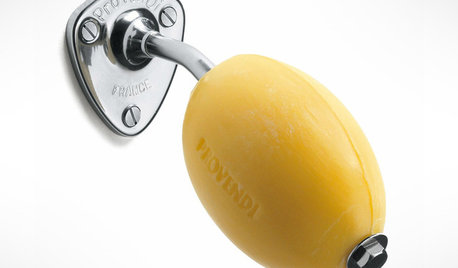


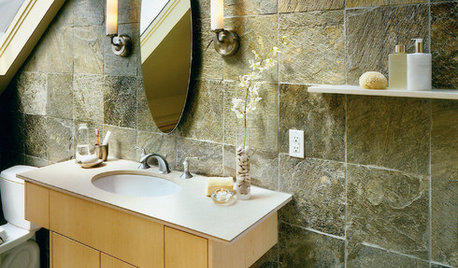


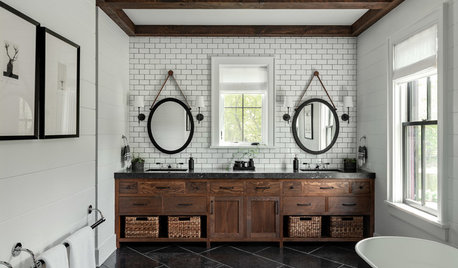
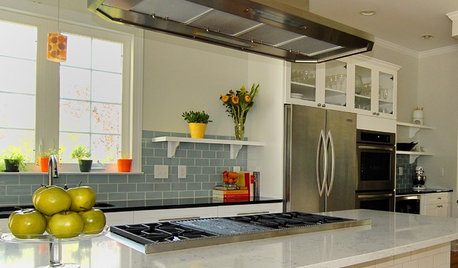
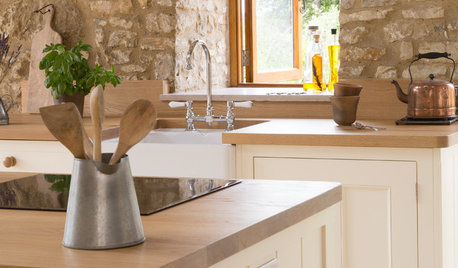









florida_joshua